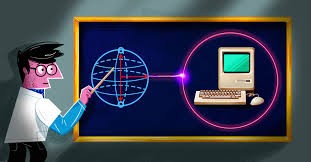
Quantum physics, with its counterintuitive principles and profound implications, is reshaping the foundations of computing in ways that were once confined to theoretical speculation. At the heart of this transformation is quantum computing, a paradigm that leverages the peculiar behaviors of subatomic particles—such as superposition and entanglement—to perform calculations that classical computers struggle to handle. While traditional computing relies on bits that exist in a state of either zero or one, quantum computing introduces qubits, which can exist in multiple states simultaneously. This fundamental shift opens the door to solving problems that are exponentially complex, offering a glimpse into a future where computation is not just faster, but fundamentally different.
The impact of quantum physics on computing is most evident in the way it challenges conventional limitations. Classical computers, no matter how powerful, are constrained by binary logic and linear processing. As data sets grow and algorithms become more intricate, these machines reach a point where performance plateaus. Quantum computers, by contrast, can process vast combinations of inputs simultaneously, thanks to superposition. This means that tasks such as factoring large numbers, simulating molecular interactions, or optimizing logistics routes could be executed in a fraction of the time. For industries like pharmaceuticals, finance, and energy, this capability could revolutionize research and operations, enabling breakthroughs that were previously out of reach.
One of the most promising applications of quantum computing lies in cryptography. Modern encryption methods rely on the difficulty of factoring large prime numbers—a task that classical computers handle with brute force and time. Quantum algorithms, such as Shor’s algorithm, threaten to disrupt this model by solving these problems exponentially faster. While this raises concerns about data security, it also prompts the development of quantum-resistant encryption techniques. The interplay between quantum physics and cybersecurity is a vivid example of how new capabilities can simultaneously create challenges and drive innovation. Businesses and governments are already investing in post-quantum cryptography to prepare for this shift.
Quantum computing also holds potential in artificial intelligence and machine learning. Training complex models requires immense computational resources, especially when dealing with unstructured data or high-dimensional spaces. Quantum algorithms could accelerate this process by exploring multiple solutions in parallel, enhancing pattern recognition and decision-making. For example, a quantum-enhanced AI system might analyze vast medical datasets to identify subtle correlations between symptoms and diagnoses, leading to more accurate and personalized treatments. The fusion of quantum physics and AI represents a frontier where two transformative technologies amplify each other’s strengths.
Despite its promise, quantum computing is still in its infancy. Building and maintaining quantum systems is a formidable challenge, requiring extreme conditions such as near-absolute-zero temperatures and precise control over quantum states. Error correction, coherence, and scalability remain significant hurdles. However, progress is steady. Companies like IBM, Google, and startups around the world are developing quantum processors and cloud-based platforms that allow researchers to experiment with quantum algorithms. These efforts are laying the groundwork for broader adoption, even as the technology matures. The journey from lab experiments to commercial applications is complex, but the trajectory is unmistakable.
The influence of quantum physics on computing extends beyond hardware and algorithms—it also reshapes how we think about information itself. In classical computing, data is discrete and deterministic. Quantum computing introduces probabilistic outcomes, where results are derived from the likelihood of different states. This shift requires a new mindset, one that embraces uncertainty and leverages it for insight. It challenges developers, analysts, and decision-makers to rethink their approaches, blending classical logic with quantum intuition. As educational institutions incorporate quantum principles into curricula, a new generation of thinkers is emerging, equipped to navigate this hybrid landscape.
From a business perspective, the strategic implications of quantum computing are profound. Early adopters stand to gain a competitive edge by solving problems faster, optimizing operations more effectively, and unlocking new capabilities. However, the path to quantum advantage requires careful planning. Organizations must assess where quantum computing aligns with their goals, invest in talent and partnerships, and stay informed about technological developments. The impact of quantum physics on computing is not just a technical story—it’s a strategic narrative that touches every aspect of innovation, risk management, and long-term growth.
In essence, quantum physics is not merely influencing computing—it is redefining it. By introducing new principles, capabilities, and challenges, it invites us to reimagine what computers can do and how they can serve us. The transition will be gradual, marked by experimentation, adaptation, and discovery. But as quantum technologies become more accessible and practical, their impact will ripple across industries, reshaping the digital landscape in ways we are only beginning to understand. The fusion of quantum physics and computing is a testament to human ingenuity—a bold step into a future where the rules are rewritten, and the possibilities are limitless.
Sources: